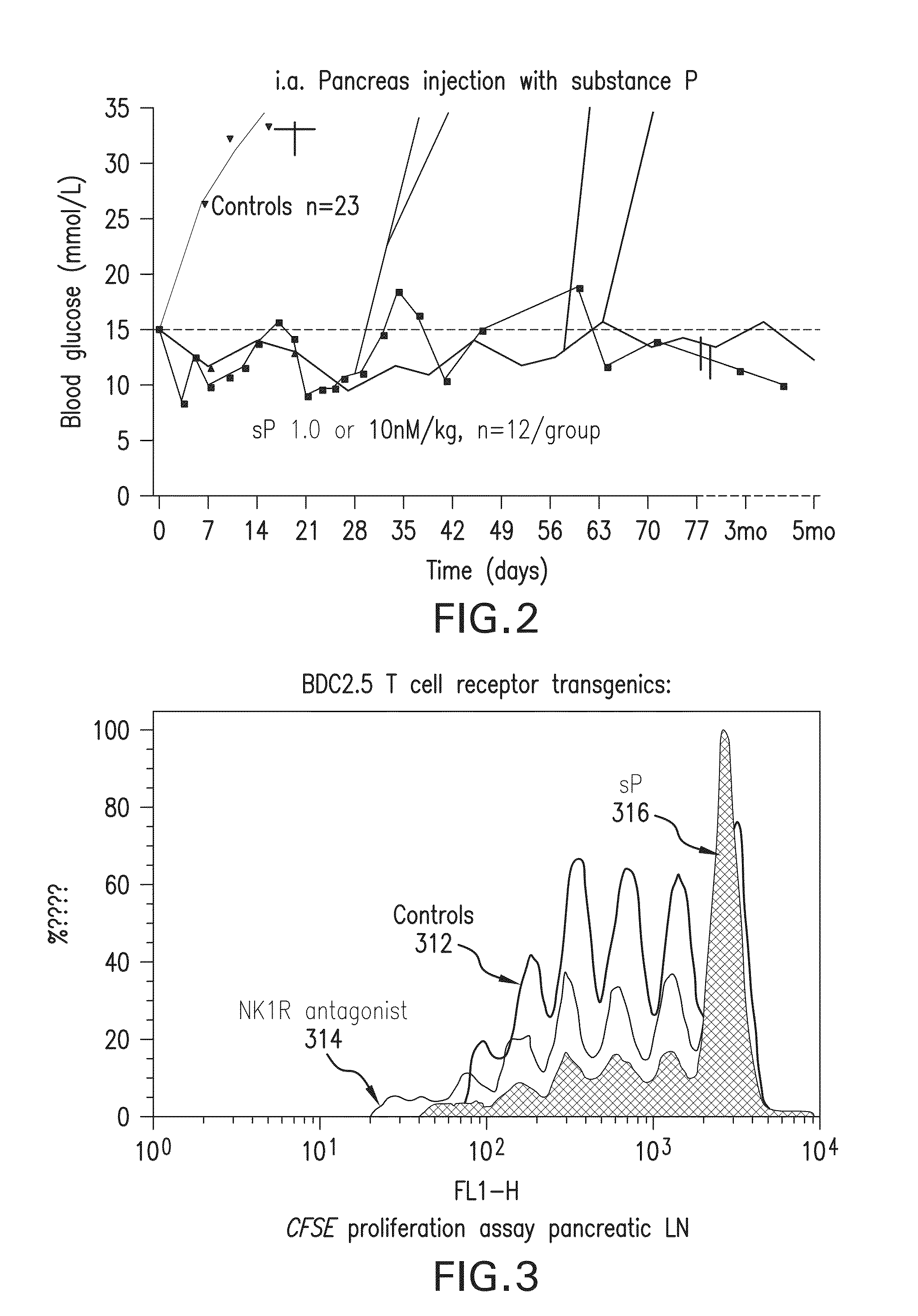METHOD FOR REVERSING RECENT-ONSET TYPE 1 DIABETES (T1D) BY ADMINISTERING SUBSTANCE P (sP)
a peptide and substance technology, applied in the direction of peptide/protein ingredients, extracellular fluid disorder, metabolic disorder, etc., can solve the problems of t1d, lifelong process plagued by t1d, and inability to cure t1d,
- Summary
- Abstract
- Description
- Claims
- Application Information
AI Technical Summary
Benefits of technology
Problems solved by technology
Method used
Image
Examples
example 1
Study Cohorts—Sample Size N=52
[0091]52 eligible, consented children or adolescents aged 10-18 years are recruited with informed, parental consent and patient assent, as appropriate. These patients have been diagnosed with T1D within ≦30 months and have a basal c-Peptide level at recruitment of ≧0.2 pmoles / mL.
[0092]Patients with recent onset T1D (CDA guidelines http: / / www.diabetes.ca / for-professionals / resources / 2008-cpg / , see below), with positive measures of typical metabolic dysfunction, insulin replacement need; T1D-associated B- & T cell autoimmunity is added, as this T1D element is one of the direct therapy targets. The patients were diagnosed at or referred to the Hospital For Sick Children, Toronto, ON, e.g. by one of the associated SickKids Satellite Diabetes Centers in the greater Toronto area. Patients are eligible for the trial, provided that: 1. they are between 10-18 years old; 2. patients are ≦30 months from diagnosis and have no other chronic illnesses other than treat...
example 2
Drug Formulation
[0098]Liquid, for Injection, substance P in 0.9% Sodium Chloride, for Injection USP. Sp-R / A™: 2 mg sP / mL and sP-Ped™: 0.5 mg sP / mL, vials: 1 mL each. cGMP-grade active pharmaceutical ingredient, API (Polypeptide Inc, San Diego, Calif., 98% pure), cGMP sterile drug manufacture outsourced to Dalton PharmaServices, Toronto. Production procedures and validation are complete and follow industry standards; manufacturing data.
example 3
Dosage Regimen
[0099]Dose finding and toxicity study—Stage A, 12 patients randomized to receiving 10-50-100 or 250 nmoles / kg i.a., 3 patients per dose group. The treatment dose was originally calculated from a count of cell surface-expressed sP receptors, NK1R, per mg mouse pancreas tissue, obtained from serial sections and extrapolated to the whole organ—not a procedure that can be duplicated in T1D patients. The sP dose was calculated to give a 100-fold saturation per surface receptor extrapolating to 2 nM / 20 g mouse, adjusting for in-tissue dwelling time and drug half life. This dose was indeed effective. New onset mouse T1D has a massive lymphocytic infiltration and many of the pancreatic surface NK1R receptors are actually carried by these infiltrating cells, in fact, most of these cells are legitimate and almost certainly prerequisite targets of sP therapy, as it triggers rapid lymphocyte death in recently activated lymphocytes (Module 1.2.3.6). This dramatically reduces autoim...
PUM
| Property | Measurement | Unit |
|---|---|---|
| temperature | aaaaa | aaaaa |
| time | aaaaa | aaaaa |
| half-life time | aaaaa | aaaaa |
Abstract
Description
Claims
Application Information
 Login to View More
Login to View More - R&D
- Intellectual Property
- Life Sciences
- Materials
- Tech Scout
- Unparalleled Data Quality
- Higher Quality Content
- 60% Fewer Hallucinations
Browse by: Latest US Patents, China's latest patents, Technical Efficacy Thesaurus, Application Domain, Technology Topic, Popular Technical Reports.
© 2025 PatSnap. All rights reserved.Legal|Privacy policy|Modern Slavery Act Transparency Statement|Sitemap|About US| Contact US: help@patsnap.com



